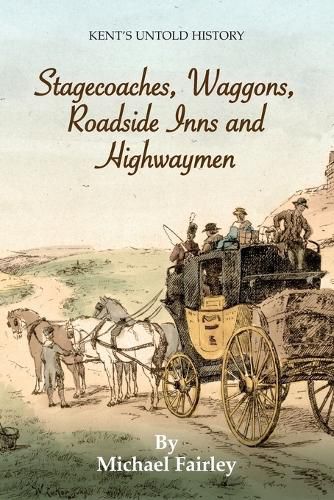Readings Newsletter
Become a Readings Member to make your shopping experience even easier.
Sign in or sign up for free!
You’re not far away from qualifying for FREE standard shipping within Australia
You’ve qualified for FREE standard shipping within Australia
The cart is loading…






Stagecoach travel in Kent was at its heyday during the second half of the 1700s and for much of the 1800s, with multiple horse-drawn coaches and carriages travelling back and forth along the London to Dover road and to and from other Kent towns, stopping to change horses or for refreshments at one or more roadside coaching inns. There were also overnight Royal Mail guarded coaches carrying letters, packets and parcels to and from Kent towns and posting inns to London. Further horse-drawn vehicles, including all kinds of two- and four-wheeled waggons, carts, and vans were daily employed in moving agricultural and other goods around the county. Later came Hackney carriages and hansom cabs in the towns, and even a few years of single and double-decker horse-drawn buses and trams. Horse-drawn travel meant there was a good trade for the many stagecoach, postal and waggon inns, for all the tradesmen making and repairing the vehicles, their wheels and harnesses, as well as ostlers and blacksmiths. It also provided the opportunity for rich pickings for the many highwaymen and footpads that frequented the Kent roads
The widespread use of horse-drawn vehicles started to decline in usage from the late 1800s and early 1900s following the quite rapid spread of the railway network throughout Kent, together with the early days of the combustion engine and the introduction of motorised transport, as well as the use of electric trams.
This story of horse-drawn transport in Kent, covering some 200 or so years, sets out what it was really like to both travel and transport goods and post on Kent's roads in centuries past. It wasn't always the most joyful of experiences and could often be quite hazardous, but it does make for interesting reading.
$9.00 standard shipping within Australia
FREE standard shipping within Australia for orders over $100.00
Express & International shipping calculated at checkout
Stagecoach travel in Kent was at its heyday during the second half of the 1700s and for much of the 1800s, with multiple horse-drawn coaches and carriages travelling back and forth along the London to Dover road and to and from other Kent towns, stopping to change horses or for refreshments at one or more roadside coaching inns. There were also overnight Royal Mail guarded coaches carrying letters, packets and parcels to and from Kent towns and posting inns to London. Further horse-drawn vehicles, including all kinds of two- and four-wheeled waggons, carts, and vans were daily employed in moving agricultural and other goods around the county. Later came Hackney carriages and hansom cabs in the towns, and even a few years of single and double-decker horse-drawn buses and trams. Horse-drawn travel meant there was a good trade for the many stagecoach, postal and waggon inns, for all the tradesmen making and repairing the vehicles, their wheels and harnesses, as well as ostlers and blacksmiths. It also provided the opportunity for rich pickings for the many highwaymen and footpads that frequented the Kent roads
The widespread use of horse-drawn vehicles started to decline in usage from the late 1800s and early 1900s following the quite rapid spread of the railway network throughout Kent, together with the early days of the combustion engine and the introduction of motorised transport, as well as the use of electric trams.
This story of horse-drawn transport in Kent, covering some 200 or so years, sets out what it was really like to both travel and transport goods and post on Kent's roads in centuries past. It wasn't always the most joyful of experiences and could often be quite hazardous, but it does make for interesting reading.